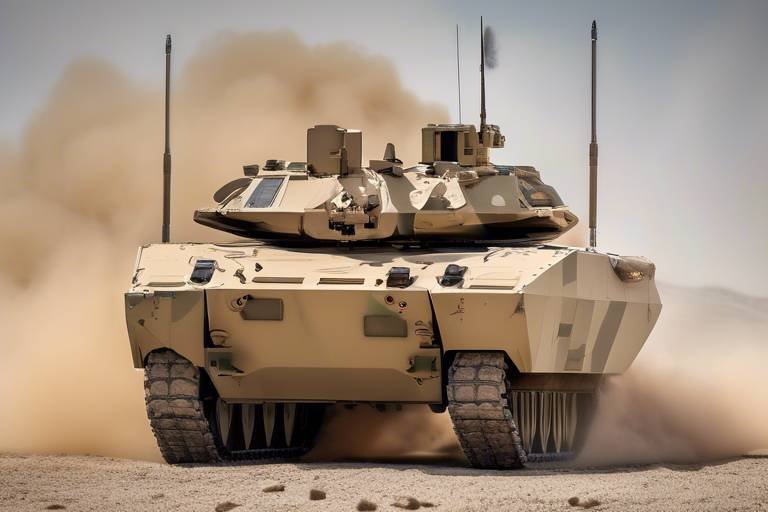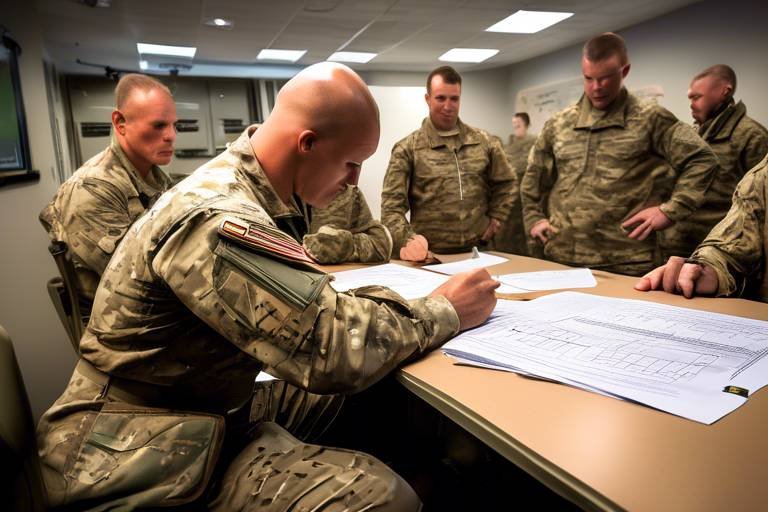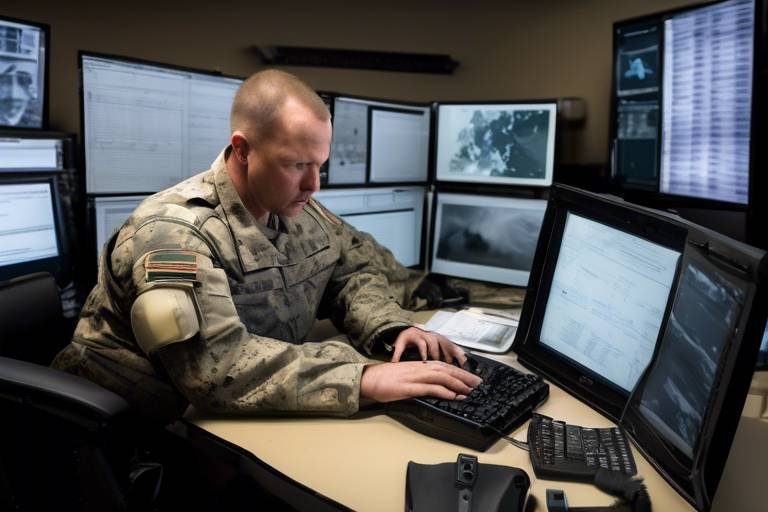Evaluating the Role of Defense Innovation in Military Strategy
In today's rapidly evolving global landscape, the role of defense innovation has never been more critical. As nations grapple with complex security challenges, advancements in defense technology are not just helpful; they are essential for maintaining a competitive edge. Imagine a chess game where each piece can evolve and adapt its strategy in real-time—that's the kind of dynamic environment military forces are navigating today. From cyber warfare to unmanned systems, the innovations being developed are reshaping the way militaries operate, strategize, and ultimately, secure their nations.
At the heart of this transformation lies the understanding that military strategy is no longer solely about brute force or numbers. It's about leveraging cutting-edge technologies to enhance operational efficiency and effectiveness. The implications are vast: improved national security, swift responses to emerging threats, and a redefined global defense dynamic. As we delve deeper into the intricacies of defense innovation, it's crucial to recognize how these advancements not only influence military operations but also shape the very fabric of international relations.
Consider the implications of a world where artificial intelligence can analyze vast amounts of data in seconds, providing military leaders with insights that were previously unimaginable. This capability not only enhances decision-making processes but also ensures that military responses are timely and informed. Furthermore, as we explore the historical context of military innovation, we can draw parallels to contemporary strategies, understanding that the lessons learned from past conflicts continue to inform our present and future.
In this article, we will examine the historical evolution of military innovation, highlighting significant case studies that showcase successful implementations. We'll also tackle the challenges that come with integrating new technologies into traditional military structures. As we move forward, we will explore the impact of these innovations on national security, delving into specific areas such as cybersecurity and artificial intelligence. Finally, we will look ahead to future trends in defense innovation, considering how emerging technologies will redefine military strategies in the years to come.
Understanding the significance of defense innovation is crucial for modern military operations, as it drives technological advancements that enhance capabilities and adapt to evolving threats in the global landscape. The military must stay one step ahead, anticipating potential challenges and developing solutions that can be deployed swiftly. This proactive approach is not just about maintaining an arsenal of weapons; it’s about cultivating a mindset that embraces change and prioritizes adaptability.
Moreover, defense innovation fosters collaboration among nations and industries, creating an ecosystem where knowledge and technology can flow freely. This collaboration is vital in an era where threats are not confined to borders. For instance, countries are increasingly sharing intelligence and resources to combat cyber threats, recognizing that a united front is more effective than isolated efforts. The synergy created through these partnerships can lead to groundbreaking advancements that benefit all parties involved.
1. What is defense innovation?
Defense innovation refers to the development and implementation of new technologies, strategies, and processes within military operations to enhance effectiveness and adapt to changing security environments.
2. Why is defense innovation important?
It is essential for maintaining national security, improving operational efficiency, and responding to emerging threats in a rapidly changing global landscape.
3. How has technology influenced military strategies?
Technological advancements have transformed military strategies by enabling faster decision-making, enhancing situational awareness, and facilitating new forms of warfare, such as cyber operations and drone usage.
4. What challenges does defense innovation face?
Challenges include budget constraints, bureaucratic hurdles, resistance to change within military organizations, and the need for ongoing training and adaptation to new technologies.
5. What are future trends in defense innovation?
Future trends may include the increased use of artificial intelligence, autonomous systems, and advancements in biotechnology, as well as the exploration of space as a new operational domain.

The Importance of Defense Innovation
Understanding the significance of defense innovation is crucial for modern military operations. In a world where threats evolve at a breakneck pace, the military must adapt and enhance its capabilities to stay ahead of potential adversaries. This is not just about having the latest gadgets; it’s about integrating cutting-edge technology into a cohesive strategy that enhances operational effectiveness. The evolution of defense technology can dramatically shift the balance of power, making innovation not just beneficial, but essential.
Consider this: every major conflict in history has been influenced by technological advancements. From the introduction of gunpowder to the advent of drones, each leap forward has redefined how wars are fought. Today, innovations such as artificial intelligence, cybersecurity measures, and autonomous systems are at the forefront of military strategy. These technologies enable forces to operate more efficiently, collect intelligence faster, and respond to threats with unprecedented speed. As we look towards a future filled with uncertainties, the question arises: how can we leverage these innovations to bolster our national security?
Moreover, defense innovation is not limited to weaponry alone. It encompasses a broad spectrum of improvements, including logistics, training, and even personnel management. For example, the use of data analytics can optimize supply chains, ensuring that troops have the resources they need when they need them. This holistic approach to innovation enhances not only the effectiveness of military operations but also the safety of the personnel involved.
However, the journey of innovation is not without its hurdles. The military often faces budget constraints, bureaucratic red tape, and a culture that can be resistant to change. This makes it imperative for military leaders to champion innovation and advocate for the necessary resources to implement new technologies. The integration of innovations must be strategic and deliberate, ensuring that they align with overarching military goals and national security objectives.
In summary, the importance of defense innovation cannot be overstated. It is the driving force behind modern military capabilities, shaping how nations prepare for and respond to threats. As we move forward, embracing innovation will be key to maintaining a competitive edge and ensuring the safety and security of our nation.

Historical Context of Military Innovation
The journey of military innovation is as old as warfare itself. From the invention of the bow and arrow to the development of nuclear weapons, each leap in technology has dramatically altered the landscape of conflict. Understanding this historical context is essential for grasping how current military strategies have been shaped and how they will continue to evolve. In fact, many modern defense paradigms can trace their roots back to pivotal moments in military history, where innovation was not just an advantage but a necessity for survival.
One of the most notable periods of military innovation occurred during the Industrial Revolution. This era introduced mechanized warfare and fundamentally changed the way battles were fought. The introduction of railroads allowed for rapid troop movement, while steam-powered ships transformed naval engagements. Innovations like the machine gun and artillery advancements made conflicts deadlier and more strategic. These changes demanded new strategies and tactics, forcing military leaders to adapt or risk defeat.
Fast forward to the 20th century, and we see how the two World Wars served as crucibles for innovation. For instance, during World War I, the use of tanks and aircraft began to emerge, shifting the focus from traditional trench warfare to more mobile and dynamic forms of combat. This trend continued into World War II, where innovations such as radar, improved aircraft designs, and the development of the atomic bomb fundamentally altered military strategies. The lessons learned from these conflicts not only shaped military tactics but also influenced geopolitical relationships for decades to come.
To illustrate the impact of historical military innovations, consider the following table that highlights key innovations and their effects:
| Innovation | Conflict | Impact on Strategy |
|---|---|---|
| Tanks | World War I | Shifted focus to mobile warfare |
| Radar | World War II | Enhanced detection and defense |
| Atomic Bomb | World War II | Introduced nuclear deterrence |
| Missile Technology | Cold War | Changed balance of power |
Moreover, the Cold War period exemplified the fierce competition in military innovation. Nations raced to develop more advanced weaponry, leading to breakthroughs in nuclear technology and missile systems. This arms race not only influenced military strategies but also reshaped international relations, as countries sought to deter adversaries through technological superiority. The lessons learned from these historical contexts continue to resonate today, as military strategists look to the past to inform their future decisions.
In summary, the historical context of military innovation is rich and complex, filled with lessons that still apply to contemporary military strategies. By examining past innovations and their impacts, we gain valuable insights into the ongoing evolution of defense technologies and strategies, preparing us for the challenges of tomorrow.
- What is military innovation?
Military innovation refers to the development and implementation of new technologies, strategies, and tactics that enhance military capabilities. - How has technology changed warfare?
Technological advancements have significantly altered how wars are fought, enabling more efficient and lethal combat methods. - What role does history play in military strategy?
History provides valuable lessons and insights that inform current military strategies and help predict future trends.
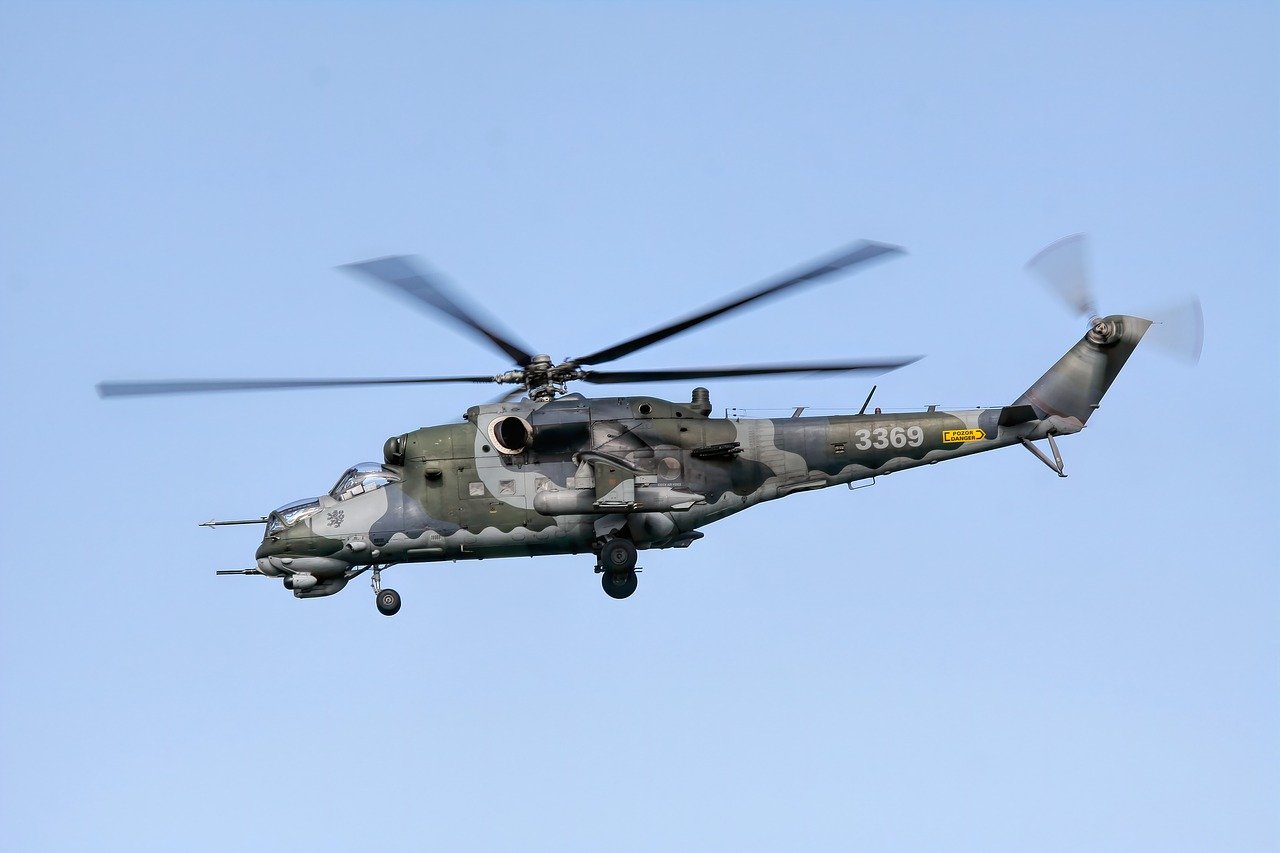
Case Studies of Successful Innovations
When we think about defense innovations, it's essential to highlight specific examples that showcase their transformative impact on military operations. These case studies not only illustrate the practical benefits of adopting new technologies but also reveal the strategic advantages that can be gained. Let's dive into a few pivotal instances that have shaped modern military strategies.
One of the most notable examples comes from the development of the tank during World War I. Initially, warfare was dominated by trench battles, which led to a stalemate on the Western Front. The introduction of the tank revolutionized ground combat, allowing forces to break through enemy lines and change the dynamics of warfare. This innovation was not just about creating a new vehicle; it represented a shift in military thinking, emphasizing mobility and combined arms operations. The success of tanks in World War I paved the way for their extensive use in World War II, where they became a cornerstone of armored warfare.
Another significant innovation can be seen in the use of unmanned aerial vehicles (UAVs), commonly known as drones. The evolution of drone technology has dramatically altered reconnaissance and combat operations. For instance, during the conflicts in the Middle East, UAVs were deployed for surveillance, targeting, and even direct strikes. This not only reduced the risk to human pilots but also allowed for precise targeting in complex environments. The success of drones has led to their integration into military strategies worldwide, showcasing how technology can enhance operational efficiency and effectiveness.
Moreover, the integration of satellite communication systems has been a game-changer in military operations. These systems allow for real-time communication and data sharing among units, regardless of their location. During the Gulf War, for example, the U.S. military's ability to coordinate air and ground forces in real time was significantly enhanced by satellite technology. This capability not only improved operational effectiveness but also provided a strategic edge against adversaries who lacked similar technological advancements.
In addition to these historical examples, we can also look at contemporary innovations. The development of cyber warfare capabilities has emerged as a critical area of focus for modern militaries. Nations are investing heavily in cybersecurity to protect their infrastructure and sensitive information from cyber threats. The 2007 cyberattack on Estonia serves as a stark reminder of the vulnerabilities that exist in the digital age. As a response, many countries have ramped up their cyber capabilities, demonstrating how innovation in this field is vital for national security.
To summarize, these case studies of successful innovations in military history highlight the importance of adapting to new technologies. From tanks and drones to satellite communications and cybersecurity, each innovation has played a crucial role in shaping military strategies and operations. As we move forward, the lessons learned from these examples will continue to inform defense policies and strategies, ensuring that militaries remain agile and prepared to face evolving threats.
- What are some examples of defense innovations? Innovations such as tanks, drones, satellite communication systems, and cyber warfare capabilities are prime examples of how technology has transformed military operations.
- How do these innovations impact military strategy? Successful defense innovations enhance operational efficiency, improve communication, and provide strategic advantages in combat situations.
- Why is it important to study historical innovations? Studying historical innovations helps inform contemporary military strategies, allowing for the adaptation of successful practices to modern challenges.
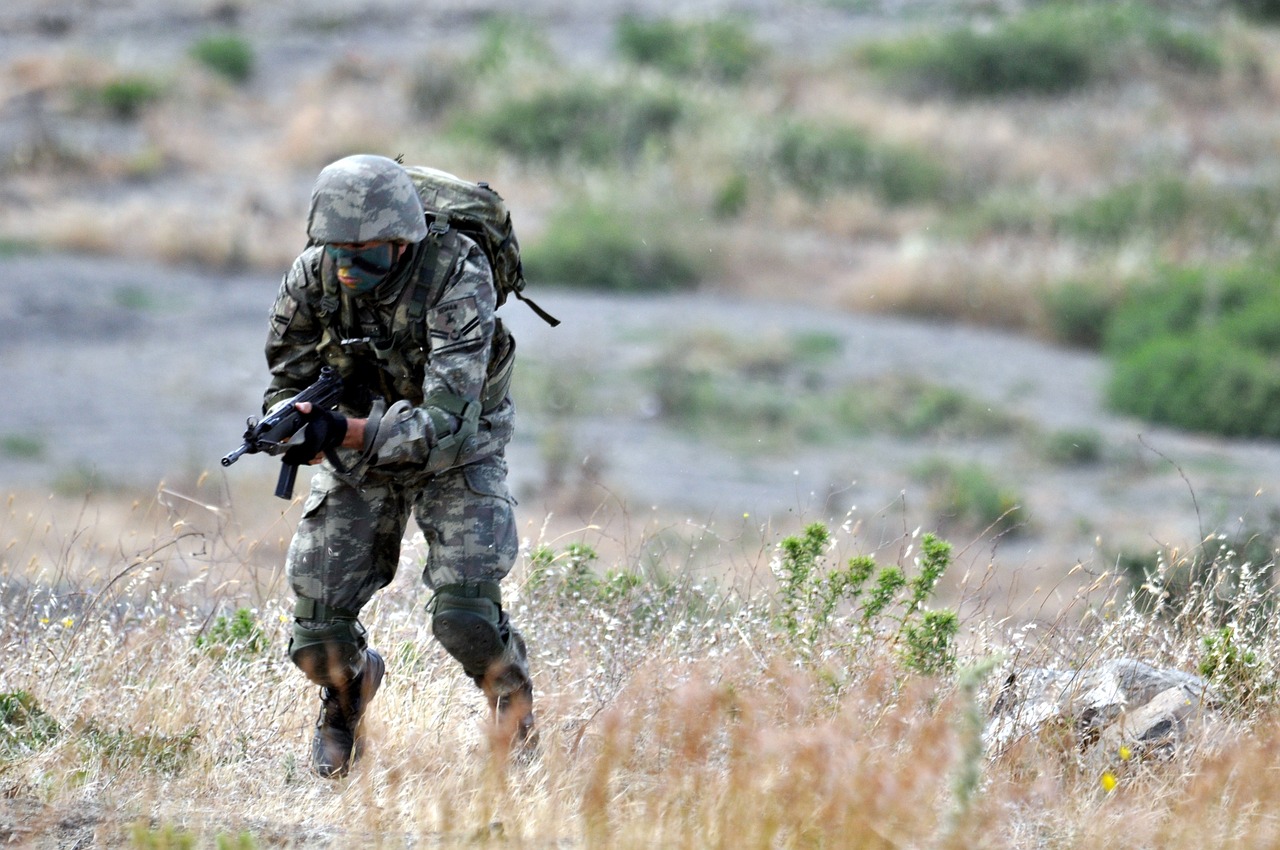
World War II Innovations
World War II was a transformative period that witnessed an explosion of technological advancements that fundamentally altered military tactics and strategies. The war served as a catalyst for innovation, forcing nations to adapt quickly to the evolving landscape of warfare. One of the most significant innovations was the development of radar technology, which allowed for early detection of enemy aircraft and ships, drastically improving defensive capabilities. Imagine being able to spot an enemy plane before it even reaches your borders! This capability not only saved countless lives but also shifted the balance of power in many engagements.
Another groundbreaking innovation was the use of aircraft carriers. These floating airbases changed naval warfare forever, allowing for long-range air strikes and providing a platform for aircraft to launch from the sea. The Battle of Midway is a prime example where aircraft carriers played a decisive role, demonstrating how air superiority could turn the tide of battle. The ability to project power far from home shores redefined military strategy and showcased the importance of air and naval coordination.
Furthermore, the development of tank technology during this period illustrated the shift towards mechanized warfare. Tanks like the German Panzer and the British Churchill were not just vehicles; they were symbols of a new era of combat. The introduction of the Blitzkrieg strategy, which emphasized rapid movement and surprise, showcased how these armored vehicles could be used effectively to penetrate enemy lines. This approach not only overwhelmed opponents but also forced a reevaluation of defensive tactics across Europe.
Moreover, World War II also saw the rise of code-breaking technologies, exemplified by the efforts at Bletchley Park, where the Allies decrypted the German Enigma machine. This intelligence breakthrough provided critical insights into enemy movements and intentions, ultimately contributing to the success of various military operations. The ability to decipher coded messages was akin to having a cheat sheet in a high-stakes game, providing a significant edge in planning and execution.
In conclusion, the innovations of World War II were not just technological marvels; they were game-changers that reshaped military doctrine and strategy. Each advancement—from radar to aircraft carriers, tanks, and code-breaking—demonstrated the necessity of innovation in warfare. As we reflect on these innovations, it’s clear that they set the stage for modern military operations, reminding us that in the world of defense, staying ahead of the curve is not just an advantage; it’s a necessity.
- What was the most significant innovation during World War II?
The development of radar technology is often considered one of the most significant innovations, as it fundamentally changed air defense strategies. - How did aircraft carriers change naval warfare?
Aircraft carriers allowed for long-range air strikes and provided a mobile platform for launching aircraft, which redefined naval engagements. - What role did code-breaking play in World War II?
Code-breaking efforts at Bletchley Park enabled the Allies to intercept and decipher enemy communications, providing crucial intelligence that influenced military decisions.

Cold War Technological Race
The Cold War era, spanning from the late 1940s to the early 1990s, was marked not only by ideological conflicts but also by a fierce technological race between the United States and the Soviet Union. This period saw an unprecedented surge in defense innovation, as both superpowers sought to outdo each other in military capabilities. The stakes were incredibly high; the outcome of this race could mean the difference between global dominance and catastrophic failure.
One of the most significant developments during this time was the advancement of nuclear technology. The arms race led to the creation of increasingly powerful nuclear weapons, with both sides investing heavily in research and development to enhance their arsenals. The introduction of intercontinental ballistic missiles (ICBMs) revolutionized military strategy, allowing for rapid and long-range delivery of nuclear payloads. This not only changed the dynamics of warfare but also necessitated new defense systems, such as missile defense shields, to counter the threat posed by these weapons.
Furthermore, the Cold War spurred innovations in surveillance technology. The need for intelligence gathering to anticipate enemy moves led to the development of advanced reconnaissance satellites and spy planes, such as the U-2 and later the SR-71 Blackbird. These technologies provided critical information that shaped military strategies and foreign policies. The ability to monitor troop movements and missile launches in real-time became a game-changer, allowing for more informed decision-making on both sides.
In addition to nuclear and surveillance advancements, the Cold War also saw significant strides in conventional military technology. The introduction of advanced aircraft, tanks, and naval vessels became essential components of military strategy. For instance, the U.S. developed the F-15 and F-16 fighter jets, which showcased superior agility and combat capabilities. Meanwhile, the Soviet Union countered with its own array of formidable aircraft, including the MiG-25, setting off a competitive cycle of innovation.
This technological race was not without its challenges. Both nations faced budget constraints and the need to prioritize spending on defense over other domestic needs. The constant push for innovation often led to bureaucratic inefficiencies, as military organizations struggled to adapt to rapid technological changes. However, the urgency of the Cold War context drove both superpowers to overcome these obstacles, resulting in breakthroughs that would shape military strategies for decades to come.
In conclusion, the Cold War technological race was a defining feature of the era that not only shaped military capabilities but also had profound implications for international relations. The innovations born out of this competition laid the groundwork for modern military strategies and continue to influence defense policies today.
- What were the key technological advancements during the Cold War?
The Cold War saw significant advancements in nuclear technology, surveillance systems, and conventional military hardware, including advanced aircraft and missile systems. - How did the technological race impact military strategies?
The technological race led to a shift in military strategies, emphasizing deterrence through advanced weaponry and the importance of intelligence gathering. - What lessons can be learned from the Cold War technological race?
The Cold War highlights the importance of innovation in maintaining national security and the need for adaptability in military organizations to respond to evolving threats.

Challenges in Implementing Innovations
Implementing defense innovations is not as straightforward as it might seem. While the potential benefits are enormous, the path to integrating new technologies into military operations is often fraught with obstacles. One of the most significant challenges is budget constraints. Military budgets are typically tight, and allocating funds for innovative projects can be a hard sell, especially when traditional methods have been in place for decades. This can lead to a situation where promising technologies are left on the drawing board simply because there isn't enough financial backing to bring them to life.
Another challenge lies in the bureaucratic hurdles that often accompany military organizations. The defense sector is notorious for its complex chain of command and lengthy approval processes. Innovations may require extensive testing, evaluation, and re-evaluation, which can slow down the adoption rate of new technologies. This bureaucracy can stifle creativity and discourage innovative thinking, as personnel may feel that their ideas will get lost in the shuffle of red tape.
Moreover, there is often a resistance to change within military organizations. Many individuals in the military have spent years honing their skills and strategies based on existing technologies. The introduction of new tools and techniques can create a sense of uncertainty and fear among personnel, leading to pushback against innovation. This cultural inertia can be particularly challenging to overcome, as it requires not only a shift in mindset but also comprehensive training and education to ensure that all members are on board with the new approach.
To illustrate these challenges, consider the following table that summarizes the primary obstacles to implementing defense innovations:
| Challenge | Description |
|---|---|
| Budget Constraints | Limited funding can restrict the development and deployment of new technologies. |
| Bureaucratic Hurdles | Complex approval processes can delay the implementation of innovations. |
| Resistance to Change | Personnel may be hesitant to adopt new technologies due to fear of the unknown. |
Additionally, there are technical challenges that must be addressed. Innovations often require new infrastructure, software, and training programs, all of which can be costly and time-consuming to implement. This is particularly true for advanced technologies like artificial intelligence and cybersecurity measures, which necessitate a level of expertise that may not currently exist within the military ranks. As such, ongoing training and development are essential to ensure that personnel can effectively utilize these innovations.
In conclusion, while the promise of innovation in defense is tantalizing, it is crucial to recognize the multifaceted challenges that come with it. By understanding these obstacles—budget constraints, bureaucratic hurdles, resistance to change, and technical challenges—military leaders can better strategize on how to navigate the complexities of integrating new technologies into their operations. This understanding is vital for ensuring that the military remains agile and capable of adapting to the rapidly evolving landscape of modern warfare.
- What are the main challenges in implementing defense innovations? Budget constraints, bureaucratic hurdles, resistance to change, and technical challenges are the primary obstacles.
- How can military organizations overcome resistance to change? Through comprehensive training, education, and fostering a culture that embraces innovation.
- Why is budget a significant concern for defense innovations? Limited funding can hinder the development and deployment of new technologies, making it difficult to implement innovative solutions.
- What role does bureaucracy play in the adoption of new technologies? Bureaucratic processes can delay approvals and slow down the implementation of innovations, creating a barrier to progress.

Impact on National Security
When we talk about national security, we often think about military forces, defense budgets, and geopolitical strategies. However, in today's rapidly evolving world, the role of defense innovation has become a cornerstone of a nation's ability to protect itself. Imagine a chess game where each move is dictated not just by the pieces on the board but also by the strategies devised by the players. In this context, defense innovation is akin to having a superior strategy that not only anticipates the opponent's moves but also adapts to them in real-time.
Advanced technologies, such as unmanned aerial vehicles (UAVs), cyber capabilities, and artificial intelligence, have transformed the landscape of military operations. These innovations don't just enhance the effectiveness of military forces; they also redefine the very concept of deterrence. For instance, a nation equipped with cutting-edge cyber defense systems can thwart potential attacks before they even occur, thus reinforcing its security posture. This proactive approach is crucial in an era where threats can emerge from unexpected quarters, such as cyber space.
Moreover, the integration of advanced technologies into national security strategies can lead to improved responses to emerging threats. Consider the rise of asymmetric warfare, where non-state actors leverage technology to challenge traditional military powers. In this scenario, innovations in intelligence gathering and real-time data analysis can provide a significant advantage. They allow for a more nuanced understanding of the battlefield, enabling military strategists to make informed decisions that can mitigate risks and enhance operational effectiveness.
However, it’s essential to recognize that with great power comes great responsibility. The rapid pace of defense innovation also raises critical questions about ethics and accountability. As nations invest in technologies like artificial intelligence for military applications, they must grapple with the implications of machines making life-and-death decisions. This ethical dilemma necessitates a reevaluation of existing frameworks and the development of new policies that ensure these innovations are used responsibly.
In addition to ethical considerations, the impact of defense innovation on national security can also be quantified through various metrics. For instance, a recent study highlighted the correlation between defense spending on technological advancements and improvements in military readiness. The table below summarizes key findings from this study:
| Year | Defense Spending (in Billion $) | Military Readiness Index |
|---|---|---|
| 2018 | 650 | 75% |
| 2019 | 680 | 78% |
| 2020 | 700 | 80% |
| 2021 | 730 | 82% |
As observed, there is a clear upward trend in military readiness as defense spending increases. This correlation emphasizes the need for continued investment in defense innovation to maintain a robust national security framework.
In conclusion, the impact of defense innovation on national security is profound and multifaceted. It not only enhances a nation's ability to deter threats but also shapes how military operations are conducted in the modern battlefield. As we move forward, it is critical for military strategists, policymakers, and ethicists to collaborate in harnessing these advancements responsibly, ensuring that national security is upheld in a manner that reflects our values and commitments to peace.
- What is defense innovation? Defense innovation refers to the development and implementation of new technologies and strategies to improve military capabilities and national security.
- How does defense innovation affect national security? It enhances deterrence capabilities, improves operational efficiency, and helps respond to emerging threats more effectively.
- What are some examples of defense innovations? Examples include artificial intelligence, cybersecurity advancements, and unmanned systems like drones.
- What ethical considerations arise from defense innovation? The use of autonomous systems and AI in military operations raises questions about accountability and the moral implications of machine decision-making.

Cybersecurity Innovations
As we navigate through an increasingly interconnected world, the importance of cannot be overstated. With the rise of digital threats, military organizations are under constant pressure to protect their sensitive information and critical infrastructure. Imagine a world where a single cyber attack could cripple a nation's defense capabilities; this is not just a hypothetical scenario, but a reality that military strategists must grapple with every day. The innovations in cybersecurity are not merely technical upgrades; they are essential adaptations to a rapidly evolving threat landscape.
One of the most significant trends in cybersecurity is the development of advanced threat detection systems. These systems utilize machine learning algorithms to analyze vast amounts of data in real-time, identifying unusual patterns that could indicate a cyber threat. By employing such technologies, military organizations can enhance their ability to detect and respond to attacks before they escalate. For instance, the integration of artificial intelligence (AI) in cybersecurity has led to the creation of automated incident response systems, which can react to threats faster than human operators, significantly reducing response times.
Moreover, the rise of quantum computing is set to revolutionize cybersecurity. While quantum computing poses a potential risk to current encryption methods, it also offers new ways to secure data transmission. Quantum encryption methods, such as Quantum Key Distribution (QKD), provide a level of security that is virtually unbreakable, making it a game-changer for military communications. As these technologies mature, they will redefine how military organizations approach data security.
However, with these advancements come challenges. The implementation of new cybersecurity technologies often faces budget constraints and bureaucratic hurdles. For instance, military organizations must ensure that their personnel are adequately trained to operate and maintain these advanced systems. Additionally, there is a cultural resistance to change within many military institutions, which can hinder the adoption of innovative practices. To overcome these challenges, a shift in mindset is required, one that embraces technology as a vital component of national security.
As we look to the future, the role of cybersecurity innovations will only continue to grow. The military must not only invest in cutting-edge technologies but also foster a culture of continuous learning and adaptation. This means regularly updating protocols, conducting training exercises that simulate cyber attacks, and collaborating with tech companies to stay ahead of emerging threats. The stakes are high, and the need for robust cybersecurity measures has never been more critical.
In summary, the innovations in cybersecurity are reshaping how military organizations protect themselves in the digital age. The integration of advanced technologies, such as AI and quantum computing, provides powerful tools to combat cyber threats. However, the successful implementation of these innovations requires overcoming significant challenges, including budget limitations and cultural resistance. As we move forward, it is imperative that military strategists prioritize cybersecurity as a cornerstone of national defense.
- What is the role of AI in cybersecurity innovations?
AI helps in automating threat detection and response, allowing faster reactions to potential cyber threats. - How does quantum computing affect military cybersecurity?
Quantum computing offers advanced encryption methods that can secure military communications against potential breaches. - What challenges do military organizations face in implementing cybersecurity innovations?
Challenges include budget constraints, bureaucratic hurdles, and resistance to change within military cultures.

Artificial Intelligence in Defense
Artificial Intelligence (AI) is not just a buzzword anymore; it’s a game-changer in the realm of defense. Imagine a battlefield where decisions are made not just by human intuition but by powerful algorithms that can analyze data in real-time. This shift is akin to moving from a horse-drawn carriage to a high-speed train—it's that significant! AI promises to revolutionize how military operations are conducted, offering enhanced efficiency, precision, and adaptability.
One of the most compelling aspects of AI in defense is its ability to process vast amounts of information at lightning speed. This capability is crucial when split-second decisions can mean the difference between success and failure. For instance, AI systems can analyze satellite images, intelligence reports, and social media feeds to identify potential threats or changes in enemy movements. By doing so, they provide military leaders with actionable insights that were unimaginable just a few years ago.
Moreover, AI can significantly improve logistics and supply chain management within military operations. By predicting equipment needs and optimizing supply routes, AI can ensure that troops receive the necessary resources without delay. This is not just a theoretical advantage; it can be the difference between life and death in critical missions. For example, AI-driven predictive maintenance can foresee equipment failures before they occur, reducing downtime and enhancing operational readiness.
However, the integration of AI into defense raises some important ethical and accountability questions. As we rely more on autonomous systems for decision-making, who is responsible if something goes wrong? This is akin to driving a self-driving car—if an accident occurs, who is at fault? Military strategists and policymakers must grapple with these dilemmas to ensure that AI is used responsibly and effectively.
To give you a clearer picture, let’s look at some of the applications of AI in defense:
| Application | Description |
|---|---|
| Autonomous Drones | AI-powered drones can conduct surveillance and even engage in combat without direct human intervention, enhancing mission capabilities. |
| Predictive Analytics | AI algorithms analyze historical data to forecast potential threats, allowing for proactive measures rather than reactive responses. |
| Cyber Defense | AI systems can detect and respond to cyber threats in real-time, protecting sensitive military information from breaches. |
| Training Simulations | AI can create realistic training environments for soldiers, adapting scenarios based on individual performance to improve readiness. |
In conclusion, the integration of Artificial Intelligence into defense strategies is not just about keeping up with technological advancements; it’s about fundamentally transforming how military operations are conducted. With the potential to enhance decision-making, improve logistics, and even redefine combat tactics, AI is set to play a pivotal role in shaping the future of national security. However, as we embrace these innovations, we must also tread carefully, ensuring that ethical considerations are at the forefront of AI implementation in defense.
- What are the primary benefits of AI in defense? AI enhances decision-making, improves logistics, and increases operational efficiency.
- Are there ethical concerns regarding AI in military applications? Yes, issues of accountability and the potential for misuse are significant concerns that need to be addressed.
- How is AI being used in cybersecurity for defense? AI systems can detect and respond to cyber threats in real-time, safeguarding sensitive military information.
- Will AI replace human soldiers? While AI will augment military capabilities, human oversight and decision-making will remain crucial in defense operations.

Future Trends in Defense Innovation
The landscape of defense innovation is constantly evolving, and understanding future trends is essential for military strategists and policymakers alike. As we look ahead, we can anticipate that emerging technologies will not only redefine operational landscapes but also reshape the very essence of military strategies. One of the most significant trends is the rise of autonomous systems. These are not just robots; they represent a paradigm shift in how military operations are conducted. Imagine drones that can make real-time decisions on the battlefield or unmanned ground vehicles that can navigate complex terrains without human intervention. The implications for operational efficiency and risk reduction are profound.
Another exciting area to watch is biotechnology. This field promises to revolutionize everything from soldier health to weapon systems. Think about it: advancements in genetic engineering could lead to enhanced physical capabilities for soldiers, while bioengineered materials could create lighter, stronger equipment. The potential to integrate biological systems with technology opens up a world of possibilities that were once the stuff of science fiction.
Moreover, the militarization of space is becoming a pressing reality. As nations vie for dominance in this new frontier, innovative strategies will be necessary to ensure security and operational superiority. This includes the development of space-based defense systems, which could provide critical advantages in surveillance and communication. However, this trend also raises ethical and legal questions about the use of space for military purposes, making it a complex issue that requires careful consideration.
Collaboration with the private sector is another trend that cannot be overlooked. The tech industry is moving at a breakneck speed, and military organizations are increasingly recognizing the value of partnering with private companies. By leveraging commercial technologies, the military can accelerate its innovation cycle, bringing cutting-edge solutions to the forefront of defense strategies. This partnership could lead to advancements in areas such as cybersecurity and artificial intelligence, enhancing the overall effectiveness of military operations.
In summary, the future of defense innovation is bright yet complex. As we embrace these trends, it is crucial to remain vigilant about the ethical implications and the potential for unintended consequences. The military must navigate these waters carefully, ensuring that advancements serve to protect and enhance national security rather than create new vulnerabilities.
- What are autonomous systems in defense?
Autonomous systems refer to technologies that can operate without human intervention, such as drones and unmanned vehicles, which are set to revolutionize military operations. - How does biotechnology impact military operations?
Biotechnology can enhance soldier capabilities and improve equipment through advancements like genetic engineering and bioengineered materials. - Why is space becoming a focus in defense innovation?
The increasing militarization of space presents new opportunities for surveillance and communication, making it a critical area for national security. - What role does the private sector play in defense innovation?
Collaborating with private companies allows the military to leverage cutting-edge technologies and accelerate the development of innovative defense solutions.
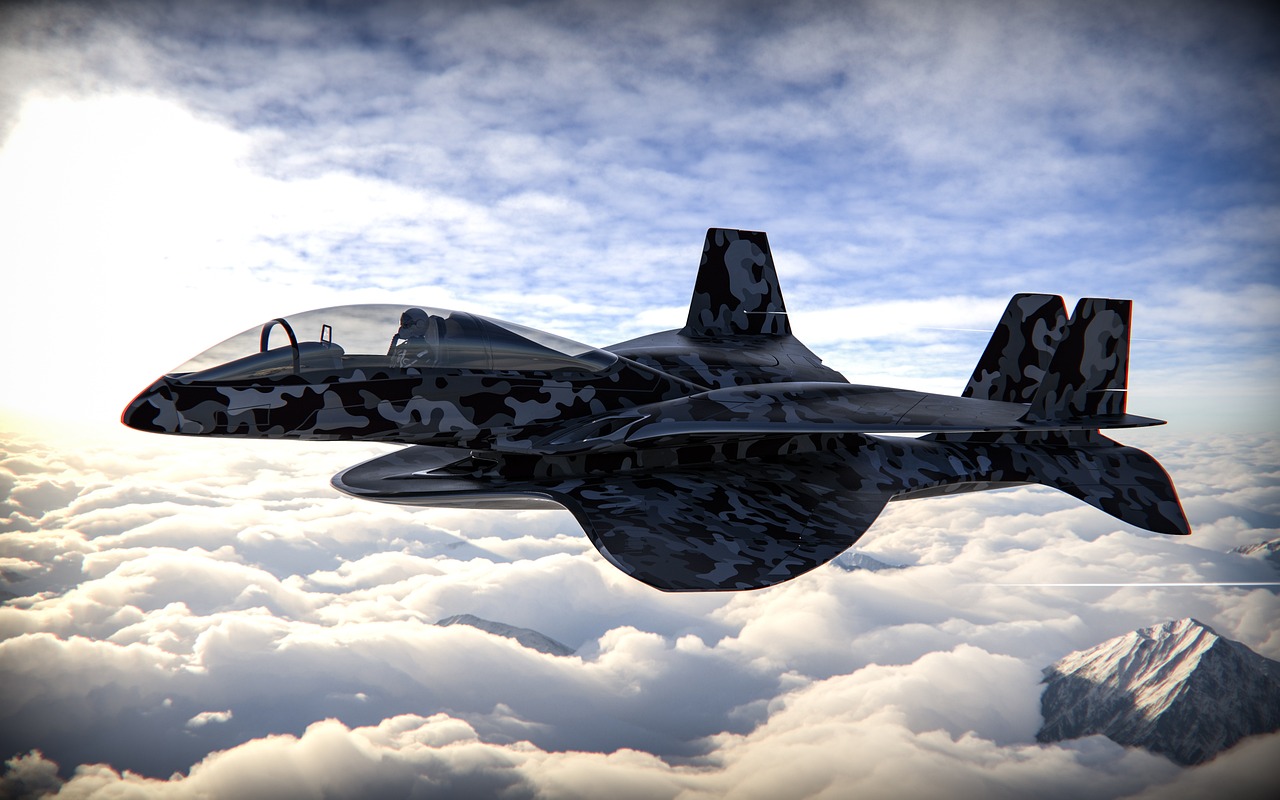
Space as a New Frontier
As we venture further into the 21st century, space has emerged as a new frontier for military strategy and defense innovation. The increasing militarization of space is not merely a futuristic concept; it is a present-day reality that demands urgent attention. Nations are recognizing that control over space resources and capabilities can significantly influence global power dynamics. This shift is akin to the historical race for territorial expansion on Earth, but now it extends beyond our atmosphere.
The potential benefits of space innovation are immense. For instance, satellite technology plays a pivotal role in enhancing communication, surveillance, and reconnaissance capabilities. These advancements allow military forces to operate with greater efficiency and precision. Imagine a battlefield where real-time data from satellites informs tactical decisions, enabling forces to respond swiftly to emerging threats. This is not science fiction; it is the current trajectory of military operations.
However, with great opportunity comes significant challenges. The militarization of space raises critical questions about international security and the potential for conflict. Just as nations once competed for dominance over land and sea, they are now vying for supremacy in space. The implications of this competition are profound, as the risk of miscalculations or misunderstandings could lead to escalations that threaten global peace. To illustrate this point, consider the following table that highlights some of the key players and their capabilities in space:
| Country | Key Capabilities | Strategic Goals |
|---|---|---|
| United States | Advanced satellite systems, missile defense | Maintain space superiority, deter adversaries |
| China | Anti-satellite weapons, lunar exploration | Expand influence, develop military capabilities |
| Russia | Satellite navigation, electronic warfare | Counter NATO, protect interests |
As we look to the future, it is clear that collaboration and regulation will be essential to navigate the complexities of space militarization. International treaties and agreements will need to evolve to address the unique challenges posed by this new domain. Just as the oceans were once the Wild West of naval power, space is becoming an uncharted territory that requires careful stewardship.
In conclusion, space is not just a new frontier; it is a battleground of innovation and strategy that will define the future of military operations. As nations continue to invest in space technologies, the need for strategic foresight and ethical considerations will become increasingly critical. The question remains: how will we balance the quest for dominance with the responsibility to foster peace and cooperation in this vast expanse?
- What are the main challenges of militarizing space? The primary challenges include the risk of conflict, the need for international cooperation, and the ethical implications of weaponizing space.
- How does space innovation impact national security? Space innovation enhances surveillance, communication, and reconnaissance capabilities, which are vital for national defense and operational efficiency.
- What role do private companies play in space defense? Private companies are increasingly involved in developing technologies that can be leveraged for military applications, fostering innovation and collaboration.

Collaboration with Private Sector
In today's rapidly evolving defense landscape, the collaboration between military organizations and the private sector has become not just beneficial, but essential. This partnership allows for a **faster** and more **efficient** integration of cutting-edge technologies into military operations. Think about it: while the military is often bogged down by bureaucratic processes, private companies can pivot quickly, adapting to new challenges and innovations. This synergy can lead to groundbreaking advancements that enhance national security and operational effectiveness.
One of the most compelling examples of this collaboration can be seen in the realm of **cybersecurity**. As threats in the cyber domain grow increasingly sophisticated, the military has turned to tech giants and startups alike to develop robust defense mechanisms. These companies, with their agile development cycles and innovative approaches, can provide solutions that are not only effective but also scalable. In fact, many military leaders now recognize that the best way to stay ahead of adversaries in cyberspace is by leveraging the creativity and expertise of the private sector.
Moreover, the collaboration extends beyond just cybersecurity. In areas such as **artificial intelligence**, **drones**, and **biotechnology**, private companies are at the forefront of research and development. The military can benefit from these advancements by integrating them into their operations, thus enhancing capabilities and ensuring that they remain competitive on the global stage. For instance, companies specializing in AI are developing algorithms that can analyze vast amounts of data in real-time, enabling military strategists to make informed decisions faster than ever before. This kind of innovation is crucial in modern warfare, where the speed of information can determine the outcome of a conflict.
However, it's important to note that this collaboration isn't without its challenges. Issues such as **intellectual property rights**, **security clearances**, and **contractual obligations** can complicate partnerships between the military and private enterprises. To navigate these complexities, both parties must engage in transparent communication and establish mutual trust. The benefits of such collaboration can far outweigh the hurdles, leading to a more resilient and innovative defense posture.
As we look to the future, fostering these partnerships will be paramount. The military must continue to seek out innovative solutions from the private sector, encouraging a culture of **innovation** and **adaptability**. By doing so, they can ensure that they are not only prepared for current threats but also capable of addressing challenges that have yet to emerge. The future of defense lies in the ability to collaborate effectively with the private sector, creating a robust ecosystem where technology and strategy work hand in hand.
- Why is collaboration with the private sector important for the military?
Collaboration allows the military to leverage innovative technologies and agile solutions that can enhance operational effectiveness and national security. - What are some areas where private sector collaboration has been beneficial?
Key areas include cybersecurity, artificial intelligence, drones, and biotechnology, where private companies lead in research and development. - What challenges exist in military-private sector partnerships?
Challenges include intellectual property rights, security clearances, and contractual obligations that need to be navigated carefully for successful collaboration. - How can the military ensure effective collaboration with private companies?
Establishing transparent communication, mutual trust, and a culture of innovation are essential for fostering successful partnerships.
Frequently Asked Questions
- What is the significance of defense innovation in military strategy?
Defense innovation is crucial as it drives technological advancements that enhance military capabilities. It helps adapt to evolving threats, ensuring that armed forces remain effective in an ever-changing global landscape.
- How have historical contexts shaped military innovation today?
Historical military innovations, like those seen during World War II and the Cold War, provide valuable lessons. They illustrate how past advancements influenced current strategies and highlight patterns that inform modern military operations.
- Can you give examples of successful defense innovations?
Absolutely! Innovations such as radar during World War II and missile technology during the Cold War transformed military tactics. These case studies demonstrate the strategic advantages gained from adopting new technologies.
- What challenges do militaries face when implementing new technologies?
Implementing defense innovations often encounters several hurdles, including budget constraints, bureaucratic obstacles, and resistance to change within military organizations. These challenges can slow down the adoption of beneficial technologies.
- How does defense innovation impact national security?
Defense innovation plays a critical role in shaping national security policies. Advanced technologies enhance deterrence capabilities and improve responses to emerging threats, making it essential for maintaining a country's safety.
- What role does cybersecurity play in defense innovation?
With the rise of cyber threats, innovations in cybersecurity are vital. They protect military infrastructure and sensitive information, necessitating a reevaluation of defense strategies in the digital age to ensure robust security measures.
- How is artificial intelligence changing military operations?
The integration of artificial intelligence into military operations is revolutionizing decision-making processes, logistics, and battlefield tactics. However, it also raises important ethical questions and concerns about accountability.
- What future trends should we anticipate in defense innovation?
Future trends in defense innovation include the rise of autonomous systems and advancements in biotechnology. These emerging technologies are likely to redefine operational landscapes and military strategies in the coming years.
- Why is space becoming a focus in military strategy?
The increasing militarization of space presents both opportunities and challenges. As nations seek to establish dominance in this new frontier, innovative strategies are necessary to ensure security and effectiveness in space operations.
- How can collaboration with the private sector enhance defense innovation?
Engaging with the private sector can accelerate defense advancements. By leveraging commercial technologies and fostering partnerships, militaries can enhance overall effectiveness and adapt more quickly to new challenges.


